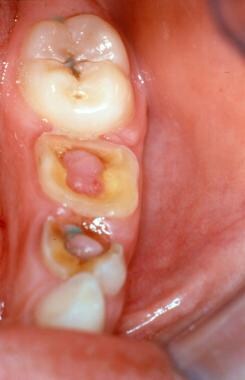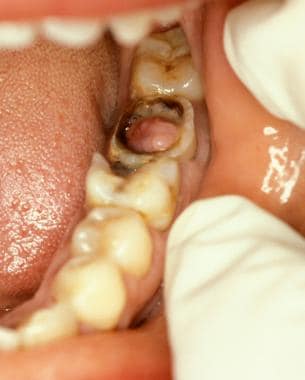Practice Essentials
The pulp polyp, also known as chronic hyperplastic pulpitis or proliferative pulpitis, is an uncommon and specific type of inflammatory hyperplasia that is associated with a nonvital tooth. See the image below.
 Pulp polyps involving the primary, first, and second mandibular molars in a young child with extensive dental caries.
Pulp polyps involving the primary, first, and second mandibular molars in a young child with extensive dental caries.
Signs and symptoms
Pulp polyps are usually asymptomatic. Direct pressure during mastication may cause mild-to-moderate tenderness. Localized bleeding may occur when the soft tissue is manipulated or traumatized.
See Presentation for more detail.
Diagnosis
Intraoral radiographs, in particular periapical and bite-wing film views, are needed to confirm this diagnosis and to determine the extent of tooth destruction and if the inflammatory lesion involves the surrounding alveolar bone.
Diagnosis and determination of the most appropriate treatment options are based on adjunctive tests, including response to percussion, thermal stimuli, and electric pulp testing.
See Workup for more detail.
Management
Treatment of a pulp polyp in a permanent tooth includes either root canal therapy or extraction of the tooth. The more conservative pulpotomy treatment has been successful in selected cases when only the coronal pulp is affected.
In immature teeth with incomplete root development, placement of an apical barrier and strengthening of the thin root with composite resin may be indicated prior to root canal treatment. Pulp revascularization of an immature permanent tooth is another treatment approach that results in the formation of vital pulpal tissue. [1]
See Treatment for more detail.
Background
Pulpal diseases are broadly divided into reversible and irreversible pulpitis and are based on the ability of the inflamed dental pulp to return to a healthy state once the noxious stimulus has been removed. In the case of the pulp polyp, the disease process is irreversible. (See the image below.) In contrast to most cases of irreversible pulpitis, the pulp polyp is usually an incidental finding that occasionally mimics reactive and neoplastic diseases of the gingiva and adjacent periodontium.
Pathophysiology
The pulp polyp is the result of both mechanical irritation and bacterial invasion into the pulp of a tooth that exhibits significant crown destruction due to trauma or caries. The mechanical causes that may stimulate this response include a tooth fracture with pulpal exposure or loss of a dental restoration. Usually, the entire dentinal roof is exposed with the crown of a carious tooth. The large exposure of pulpal tissue to the oral environment and bacterial invasion results in a chronic inflammatory response that stimulates an exuberant granulation tissue reaction.
The hyperplastic tissue reaction occurs because the young dental pulp has a rich blood supply and favorable immune response that is more resistant to bacterial infection. Furthermore, because the tooth is open to the oral cavity, transudates and exudates from the inflamed pulpal tissue drain freely and do not accumulate within the restricted and rigid confines of the tooth. Tissue necrosis with destruction of the microcirculation that usually accompanies irreversible pulpitis does not occur in part because of this lack of significant intrapulpal pressure. In young teeth in which the apex of the root is open, the risk of pulpal necrosis secondary to venous congestion is decreased. The presence of a rich vascular network in the young pulpal tissue is an important protective mechanism against the inflammatory response that significantly decreases with age.
The possible role of a type 1 hypersensitivity reaction has been hypothesized because of an increased presence and concentration of immunoglobulin E (IgE), histamine, and interleukin-4 (IL-4) within the pulp polyps when compared with healthy pulpal tissues. [2]
Etiology
Causes of a pulp polyp include the following:
-
Carious tooth with significant loss of tooth structure
-
Loss of a dental restoration that results in pulpal exposure
-
Fractured tooth due to trauma with a pulpal exposure
-
Pulpal tissue with access to a good blood supply
-
Possible hormonal (estrogen and progesterone) influence
-
Possible hypersensitivity reaction
In a Danish study, hyperplastic pulps were observed only in extremely deep carious lesions, which tended to have bacteria in contact with the pulpal tissue, the presence of an inflammatory infiltrate, and partial pulp necrosis. Extremely deep lesions were defined as carious lesions that penetrated the entire thickness of the dentine, without a radio-dense zone. [3]
Epidemiology
United States data
Pulp polyps are reportedly uncommon in the United States, and no epidemiologic studies specifically document the frequency of this entity. Although this lesion is reported to be uncommon with only isolated references in the literature, the true prevalence of this reactive pulpal disease is likely to be underestimated because it is a well-recognized sequela of extensive dental caries in children.
International data
Pulp polyps are uncommon in countries with routine access to dental care, but they are encountered more frequently in developing countries. In a study of Vietnamese refugees who sought dental care, the prevalence of pulp polyps was 6%. This high number of cases is an indication of the severity of dental disease in this impoverished population. In a Brazilian clinical study of traumatized primary teeth, the occurrence of pulp polyps was 2.3% in young children. [4]
Race-, sex-, and age-related demographics
No racial predilection is recognized for this sequela of dental caries; however, it is more common in individuals of lower socioeconomic background who have limited access to dental care than in other people.
No sexual predilection has been documented for this oral lesion.
This pulpal disease occurs almost exclusively in children and young adults, and it can occur in both the primary dentition and the permanent dentition. When trauma is the causative factor in primary anterior teeth, most examples are observed in children aged 2 years or younger.
Prognosis
The prognosis is excellent. No risk for recurrence exists once definitive treatment has been rendered.
Morbidity/mortality
Pulp polyps tend to be asymptomatic and are not associated with any significant morbidity or mortality except for gross caries destruction with premature tooth loss in many cases.
Complications
Space discrepancy from crown destruction or premature loss of a tooth may result in a crowded malocclusion, supereruption of an opposing tooth, or the impaction of a succedaneous tooth.
Without definitive treatment, some of these long-standing, nonvital teeth may progress to symptomatic disease, including periapical inflammatory disease and (rarely) cellulitis and osteomyelitis of the jaws.
Patient Education
Reinforce the importance of routine oral health care to prevent the development of deep carious lesions that may cause inflammatory pulpal disease and more serious sequelae.
For excellent patient education resources, visit WebMD's Oral Care Center. Also, see WebMD's patient education article Tooth Decay Prevention.
-
Pulp polyps involving the primary, first, and second mandibular molars in a young child with extensive dental caries.
-
Pulp polyp involving the permanent second mandibular molar in a young adult with multiple carious teeth.
-
Fibrosed pyogenic granuloma of the mandibular gingiva that partially surrounds a carious molar with crown destruction. Reactive gingival lesions that extend into a large carious lesion of an adjacent tooth may resemble a pulp polyp.
-
Low-power photomicrograph of a pulp polyp demonstrating inflamed fibrovascular tissue that is lined by stratified squamous epithelium (hematoxylin and eosin, original magnification X40).
-
Intermediate-power photomicrograph of a pulp polyp with superficial bacteria and exogenous, pigmented material overlying the surface epithelium (hematoxylin and eosin, original magnification X100).






